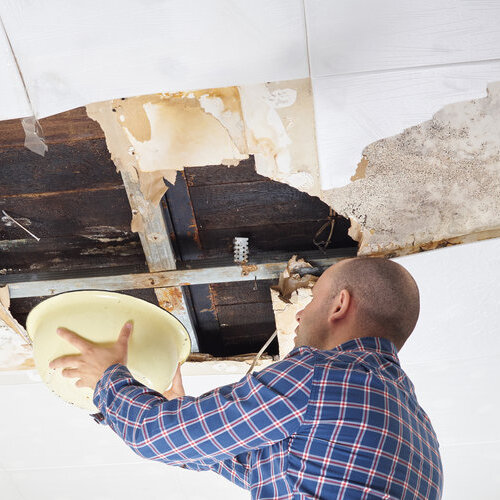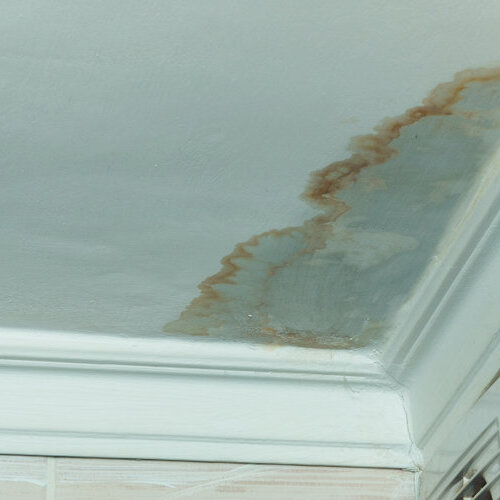
Dealing With a Leaky Roof
Biloxi, Mississippi is a beautiful area that has its share of bad weather, and that bad weather can leave commercial structures and residential properties alike in need of emergency roof repair or roof replacement. So what is an emergency roof repair exactly?
For either a commercial or residential structure, a leaking roof would be a seemingly obvious emergency roof repair. But not every roof leak is an emergency – although they all need to be repaired. A roofing contractor measures what makes an obvious emergency roof repair an emergency with these factors:
- Some causes of roof leaks include a tree branch, limb, tree, or other object that has fallen or been blown onto a roof, creating a hole. With a hole, the roof is in danger of caving in, and there’s nothing to keep the elements from coming inside.
- Roofing shingles or other roofing materials like the flashing can be loosened or torn away. This leads to areas where the roof can start leaking as the water begins coming in.
- If a tarp must be temporarily installed over an area of the roof to keep more water from coming in, this is considered an emergency roof repair. Note that a tarp is a temporary repair and a more durable repair should be done.
- Not all emergency roof repairs are caused by trees and flying debris in a storm. A fire can burn a section of a roof and compromise the roof’s integrity. A fire can damage the roof deck, joints, and the roof material.
What does a roof leak look like?
Evidently, if there is water is everywhere, you either have an emergency roof leak on your hands or an issue such as a busted water heater. Indicators such as where the water is standing will tell you if the problem is an issue like a leak in the water heater or a roofing emergency. There are a few things to look for to determine whether you have a roof leak. Some roof leaks are large, some are small, and they may appear very differently. A few indicators, other than an obvious sign like a hole in the roof, would be any of the following:
1. Water Stains
A water stain may appear as a spot like a brown ring around what appears to be a puddle of water on the ceiling. A leaking ceiling isn’t always easy to identify, especially if the spot is in a dark corner or the stains are small. Once you notice these stains, check closer for discoloration, moisture, and mold.
2. Dripping
If there is moisture on the wall or dripping water, you could be dealing with a leaking roof. This small of a leak may disappear as quickly as you notice it, but that doesn’t mean the leak has quit. Especially during the winter, there may be an ice dam caused by ice and snow freezing, thawing, melting, and refreezing. As it thaws, the water seeps under the shingles, and in short time you’ll have an intermittent roof leak.
3. Exterior Walls With Spots
Once a month and after a weather event, walk around your home, checking the roof line. If you notice water spots under the eaves or where the roof and walls meet, this could be from loose or missing flashing.
4. Green Growth
When a roof has algae, moss, or mold growing on it, typically on the shaded side of the house, this means there is moisture under the shingles. This may be more dangerous than you think because algae, moss, and mold can start eating away at the roofing. This indicates that you should check in the attic for a possible roof leak.
5. Missing Shingles or Debris In the Downspouts
Missing shingles are leaving your roof vulnerable to an emergency roof leak if not addressed. If the seams between the shingles are loose or the gutter downspouts are filled with asphalt granules and other debris, you could be dealing with the beginnings of a slow leak in the attic, inside the wall, or in the crawl space.
Can you fix a leaking roof in the rain?
Yes, but to do a temporary emergency roof repair, you first need to know how to find a roof leak. This will require going into the attic with a flashlight. With the flashlight, look for the following:
- Dark spots on the insulation and roof joists.
- Look for mildew and mold growth and smell.
- Discoloring from water stains on the roofing material and roof joists.
- Check for condensation on all surfaces.
- Look for damaged insulation like dampness, holes, or stains.
Next, turn off the flashlight off and see if there is any sunlight coming through the roof. If you see any, this means there are gaps or holes that need to be taken care of. If there is water coming through, it’s time for an emergency roof repair.
How do I temporarily fix my roof?
As a homeowner, it is important to know how to handle an emergency roof repair because a roofing contractor isn’t always going to be available as soon as you call. With a plastic tarp, 2×4 boards, and nails or screws, you can make a temporary patch on top of the roof.
- Measure the area of the damage and add 2 to 3 inches.
- Cut the 2×4 board to fit those measurements.
- Stretch the plastic tarp over the hole and place the 2×4 board around the edges of the damaged area.
- Nail or screw the boards into the roof to hold the tarp down.
On the inside, with a piece of plywood or roofing shingles and some 2×4 boards, cover the hole from the underside. Apply roofing tar around the edges of the damage and then plywood over that. Press them into place with the 2×4 board and nail or screw them into place.

Final Notes
If you don’t have permanent or even temporary emergency roof repairs done, you may wonder, can a roof leak cause mold? Yes – with unattended and unrepaired roof leaks, moisture will lead to mildew, and mold will grow. It then spreads through the attic, to the ceiling, into the air vents, and throughout your home.
Is a roof leak covered by insurance? If the emergency roof repair is caused by an unplanned event like high winds or a hailstorm, in most cases your homeowner’s insurance will pay for repair or replacement. However, if the insurance adjuster determines the roof was neglected – meaning you should have replaced it sooner – they may decline your claim. This is why it’s always important to invest in seemingly minor roof repairs and maintenance before they become much bigger issues.


